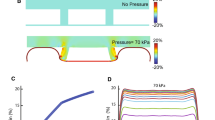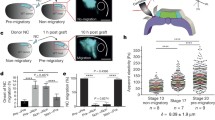Abstract
Coordinated collective cellular movements underlie embryonic development. Mechanosensitivity of collective movements of cells in model systems allows us to suggest that cellular migration can be regulated in normal development by the stage-specific patterns of mechanical forces within the tissue, which was first described for the embryos of Anura. Experimental validation of this hypothesis is incomplete and requires further research. One of the key findings supporting this hypothesis will be registration of trajectories of cell movement in an explant subjected to mechanical deformation comparable to that in normal development. This task requires protocol for controlled deformation to embryonic tissues that will allow subsequent time-lapse imaging of stretched samples with a resolution sufficient to recognize individual cells. In this article, we performed stretching of embryonic tissue explants on an elastic substrate using the device for controlled uniaxial deformation developed in our laboratory. This allowed us to capture the movements of individual cells in stretched explants of the blastocoel roof of the middle gastrula of X. laevis and reveal the threshold values of the rate and time of stretching required to initiate cell movements within the explant.


Similar content being viewed by others
REFERENCES
Azioune, A. et al., Robust method for high-throughput surface patterning of deformable substrates, Langmuir, 2011, vol. 27, no. 12, pp. 7349–7352.
Beloussov, L.V. et al., Mechanical stresses and morphological patterns in amphibian embryos, J. Embryol. Exp. Morphol., 1975, vol. 34, no. 3, pp. 559–574.
Beloussov, L.V. et al., Tension-dependent collective cell movements in the early gastrula ectoderm of Xenopus laevis embryos, Dev. Genes Evol., 2000, vol. 210, no. 2, pp. 92–104.
Beloussov, L.V. et al., Local and global dynamics in collective movements of embryonic cells, BioSystems, 2018, vol. 173, pp. 36–51.
Carpi, N. and Piel, M., Stretching micropatterned cells on a PDMS membrane, J. Vis. Exp., 2014, no. 83, pp. 1–6.
Das, T. et al., A molecular mechanotransduction pathway regulates collective migration of epithelial cells, Nat. Cell Biol., 2015, vol. 17, no. 3, pp. 276–287.
Davidson, L.A. et al., Mesendoderm extension and mantle closure in Xenopus laevis gastrulation: combined roles for integrin α5β1, fibronectin, and tissue geometry, Dev. Biol., 2002, vol. 242, no. 2, pp. 109–129.
Dumortier, J.G. et al., Collective mesendoderm migration relies on an intrinsic directionality signal transmitted through cell contacts, Proc. Natl. Acad. Sci. U. S. A., 2012, vol. 109, no. 42, pp. 16945–16950.
Evstifeeva, A.Y. et al., Stress-generating tissue deformations in Xenopus embryos: long-range gradients and local cell displacements, BioSystems, 2018, vol. 173, pp. 52–64.
Goddard, G.K. et al., Applying tensile and compressive force to Xenopus animal cap tissue, Cold Spring Harbor Protoc., 2020, vol. 2020, no. 3, pp. 68–74.
Nestor-Bergmann, A. et al., Decoupling the roles of cell shape and mechanical stress in orienting and cueing epithelial mitosis, Cell Rep., 2019, vol. 26, no. 8, pp. 2088–2100. e4.
Nieuwkoop, P.D. and Faber, J., Normal table of Xenopus laevis (Daudin), Copeia, 1958, vol. 1958, no. 1, p. 65.
Pfister, K. et al., Molecular model for force production and transmission during vertebrate gastrulation, Development, 2016, vol. 143, no. 4, pp. 715–727.
Ramos, J.W. and DeSimone, D.W., Xenopus embryonic cell adhesion to fibronectin: position-specific activation of RGD/synergy site-dependent migratory behavior at gastrulation, J. Cell Biol., 1996, vol. 134, no. 1, pp. 227–240.
Sive, H.L. et al., Early Development of Xenopus laevis: A Laboratory Manual, CSHL Press, 2000, pp. 249–297.
Solnica-Krezel, L., Conserved patterns of cell movements during vertebrate gastrulation, Curr. Biol., 2005, vol. 15, no. 6, pp. 213–228.
Stepien, T.L., et al., Using a continuum model to decipher the mechanics of embryonic tissue spreading from time-lapse image sequences: an approximate Bayesian computation approach, PLoS One, 2018, vol. 14, no. 6, pp. 1–23.
Wang, J.H.C., et al., Specificity of endothelial cell reorientation in response to cyclic mechanical stretching, J. Biomech., 2001, vol. 34, no. 12, pp. 1563–1572.
Weber, G.F. et al., A mechanoresponsive cadherin-keratin complex directs polarized protrusive behavior and collective cell migration, Dev. Cell, 2012, vol. 22, no. 1, pp. 104–115.
ACKNOWLEDGMENTS
We are grateful to Dr. Dietmar Gradl (Karlsruhe Institute of Technology, Karlsruhe) for kindly providing GAP43-GFP and H2B-mCherry plasmids containing target sequences of fluorescent markers of cell membranes and nuclei, respectively, to S.V. Kremnev for invaluable assistance in the synthesis of fluorescent RNA markers and M.M. Moisenovich for his assistance in the implementation of the stretching device.
Funding
The reported study was funded by the Russian Foundation for Basic Research, project nos. 19-34-90191 and 20-01-00329 and a State Assignment of Koltsov Institute of Developmental Biology, Russian Academy of Sciences (theme 0088-2021-0009). The work was performed using the equipment of the Core Centrum of Koltsov Institute of Developmental Biology, Russian Academy of Sciences.
Author information
Authors and Affiliations
Contributions
D.V. Bredov developed the concept of the article.
I.V. Volodyaev, N.N. Luchinskaya, and D.V. Bredov planned the experiment.
N.N. Luchinskaya carried out obtaining of embryos and microinjection of fluorescent markers.
D.V. Bredov provided stretching experiments and lifetime time-lapse imaging of embryos.
D.V. Bredov and N.N. Luchinskaya carried out data analysis.
Corresponding author
Ethics declarations
Conflict of interest. The authors declare that they have no conflicts of interest.
Statement on the welfare of animals. All applicable international, national, and/or institutional guidelines for the care and use of animals were followed.
Additional information
The data were presented at the conference of young scientists “Actual Problems of Developmental Biology” October 12–14, 2021, Moscow, Koltzov Institute of Developmental Biology, Russian Academy of Sciences
Translated by A. Ermakov
Rights and permissions
About this article
Cite this article
Bredov, D.V., Luchinskaya, N.N. & Volodyaev, I.V. Introducing a Method for Controllable Deformation of Embryonic Tissues to Study Mechanodependent Cell Movements. Russ J Dev Biol 53, 121–127 (2022). https://doi.org/10.1134/S1062360422020047
Received:
Revised:
Accepted:
Published:
Issue Date:
DOI: https://doi.org/10.1134/S1062360422020047




